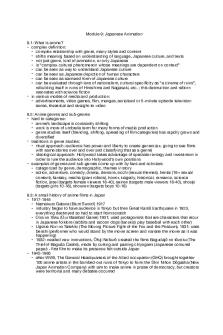Module 9 - Psych - Lecture notes 26 PDF

| Title | Module 9 - Psych - Lecture notes 26 |
|---|---|
| Course | Principles Of Psychology |
| Institution | University of Northern Colorado |
| Pages | 2 |
| File Size | 66 KB |
| File Type | |
| Total Downloads | 78 |
| Total Views | 149 |
Summary
Audrey Jeannine Tocco was my professor at University of Northern Colorado while taking Principles of Psychology...
Description
Definitions Add ons Topics Sections Drugs
Tolerance and Addiction in Substance Use Disorder ● Psychoactive Drug - A chemical that changes perceptions and moods ~ A drug’s overall effect depends on biological effects and on the user’s expectations ● Substance Use Disorder - A disorder characterized by substance craving and use despite significant life description or physical risk ● Tolerance - Brain chemistry adapts to offset the drug effect, causing people to take more and more of the drug in order to feel an effect ~ Tolerance increases the risk of becoming addicted ● Withdrawal - Discomfort and distress that occurs when someone stops taking an addictive drug Types of Psychoactive Drugs ● Three major categories ~ Depressants - Reduce neural activity and slow body functions ~ Alcohol ~ Slows brain activity that controls judgment and inhibitions ~ Alcohol Use Disorder - Alcohol use marked by tolerance, withdrawal and a drive to continue use ◌ Prolonged and excessive drinking ~ Disrupts memory formation, partly by suppressing REM sleep ~ Reduces self-awareness ~ Barbiturates - Depress nervous system activity ~ Tranquilizer ~ Reduces anxiety ~ Impairs memory and judgment ~ Opiates - Depress neural functions ~ Heroin, oxycontin, morphine, codeine ~ Lessen pain and anxiety ~ Stimulants - Excited neural activity and speed up body functions ~ Caffeine, nicotine, cocaine, amphetamines, meth, ecstasy ~ Nicotine ~ Stimulating and highly addictive drug from tobacco ~ Smoking cigarettes causes people to develop tolerance and withdrawal if they try to quit ~ Within 7 seconds of smoking a cigarette: ◌ Epinephrine (adrenaline) diminishes appetite and boosts alertness, anxiety and pain are reduced
~ Cocaine ~ Stimulant derived from the Coca plant ~ Depletes brain’s supply of stimulating neurotransmitters, temporarily increasing alertness and euphoria ~ Methamphetamine - Stimulates neural activity ~ Triggers the release of dopamine, raising energy and mood ~ Ecstasy - Street name for MDMA ~ Triggers dopamine release ~ Releases sorted serotonin blocking reuptake ~ Hallucinogens - Distort perceptions and evoke sensory images without sensory input ~ People feel separated from their body and experience dreamlike scenes ~ LSD (acid) ◌ Emotions range from euphoria to panic ~ Marijuana ~ Contains THC ~Mild hallucinogen, amplifies sensitivity to colors, sounds, tastes, and smells ~ Relaxes, disinhibits and produces a high ~ Lingers in the body for over a week Influences on Drug Use ● Biological Influences ~ Heredity - If parents or twins have substance abuse disorder, that child or twin is more likely to develop substance abuse disorder ~ Variations in neurotransmitter systems ● Psychological ~ Lacking sense of purpose ~ Stress ~ Psychological disorders ● Social-Cultural Influences ~ Difficult environment ~Cultural acceptance of drug use ~ Negative peer influences...
Similar Free PDFs

Psych 100 - Lecture notes 1-26
- 18 Pages

Psych Class 9 - Lecture notes 9
- 2 Pages

Chapter 26 - Lecture notes 26
- 5 Pages

Cnidaria - Lecture notes 26
- 1 Pages

Lect25-26 - Lecture notes 25-26
- 21 Pages

Lecture Notes (Psych)
- 43 Pages

Psych 100 - lecture notes
- 20 Pages

UCSP Module 9 - Lecture notes 1-18
- 20 Pages
Popular Institutions
- Tinajero National High School - Annex
- Politeknik Caltex Riau
- Yokohama City University
- SGT University
- University of Al-Qadisiyah
- Divine Word College of Vigan
- Techniek College Rotterdam
- Universidade de Santiago
- Universiti Teknologi MARA Cawangan Johor Kampus Pasir Gudang
- Poltekkes Kemenkes Yogyakarta
- Baguio City National High School
- Colegio san marcos
- preparatoria uno
- Centro de Bachillerato Tecnológico Industrial y de Servicios No. 107
- Dalian Maritime University
- Quang Trung Secondary School
- Colegio Tecnológico en Informática
- Corporación Regional de Educación Superior
- Grupo CEDVA
- Dar Al Uloom University
- Centro de Estudios Preuniversitarios de la Universidad Nacional de Ingeniería
- 上智大学
- Aakash International School, Nuna Majara
- San Felipe Neri Catholic School
- Kang Chiao International School - New Taipei City
- Misamis Occidental National High School
- Institución Educativa Escuela Normal Juan Ladrilleros
- Kolehiyo ng Pantukan
- Batanes State College
- Instituto Continental
- Sekolah Menengah Kejuruan Kesehatan Kaltara (Tarakan)
- Colegio de La Inmaculada Concepcion - Cebu







